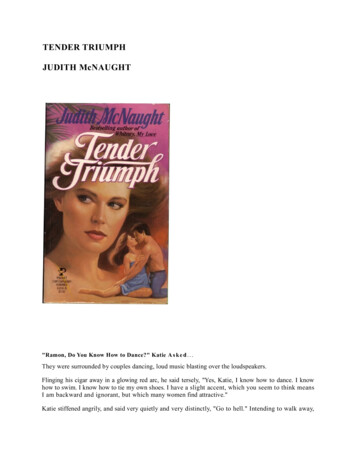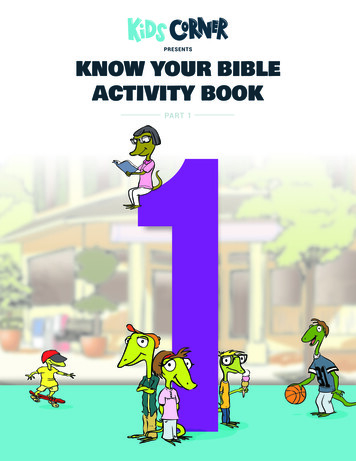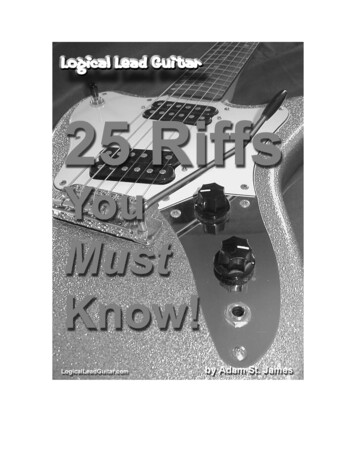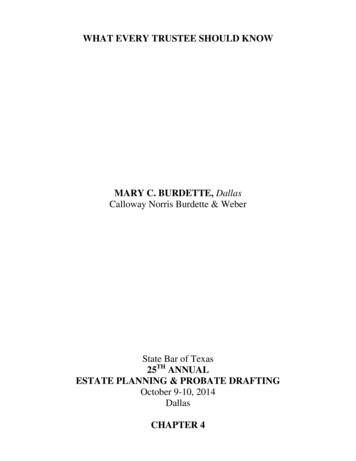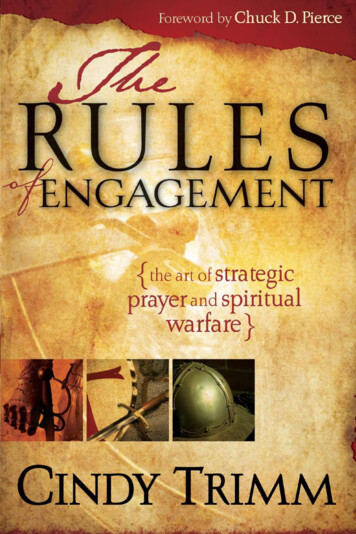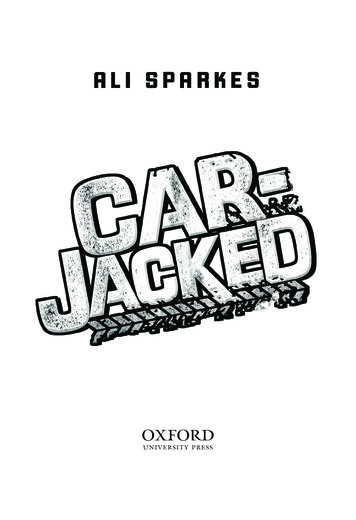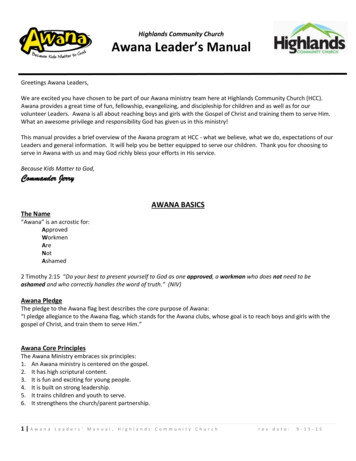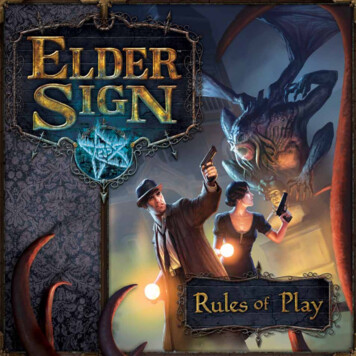
Transcription
I know I will be called insane for what Iam about to do. But you must believe me whenI tell you that this museum is alive, infectedwith an ancient evil. Once these diabolicalforces become manifest, they will reducehumanity to cinders. Night after night, Ihave scoured the exhibits and relics, fightingto keep the horrors at bay and learning whatI can. I believe I have discovered a way toprevent our doom. Ancient cultures crafted astrange symbol to drive off these creatures.They called it the Elder Sign.Components This Rulebook Clock Cardboard Clock Hand 1 Plastic Connector (for the clock hand) 6 Green Dice 1 Yellow Die 1 Red Die 1 Entrance Reference Sheet 80 Oversized Cards consisting of:-- 16 Investigator CardsOverview-- 8 Ancient One CardsIn Elder Sign, 1 to 8 players take on the role of investigatorsstruggling to combat one of the Ancient Ones—vast, powerfulcreatures that dwell in the space between dimensions.-- 8 Other World Adventure CardsThe investigators face adventures in and around the museumwhere the Ancient One’s imminent return has been causinga number of bizarre events. Through these adventures, theinvestigators acquire rewards. The most prized resource thatcan be gained is an Elder Sign, which is used to seal away theAncient One and win the game.But the clock is always ticking and each night at midnight, theAncient One gets closer to waking up in our world and layingwaste to all of humanity.Object of the GameThe object of Elder Sign is to seal the Ancient One away beforeit awakens or, failing that, send the creature back where it camefrom in a last ditch, nearly hopeless final battle.To seal away the Ancient One, the investigators mustaccumulate the number of Elder Signs shown on the AncientOne’s card before its Doom track fills up and it awakens.If the Ancient One awakens, the investigators have one lastchance to drive the creature away. Players should be warned,however, that combat against the Ancient One almost alwaysends in failure and death.-- 48 Adventure Cards 76 Small Cards consisting of:-- 12 Common Item Cards-- 12 Unique Item Cards-- 12 Spell Cards-- 8 Ally Cards-- 32 Mythos Cards 144 Cardboard Tokens and Markers consisting of:-- 16 Investigator Markers-- 30 Sanity Tokens-- 30 Stamina Tokens-- 15 Clue Tokens-- 22 Monster Markers-- 5 Mask Monster Markers-- 12 Doom Tokens-- 17 Elder Sign TokensComponent DescriptionsThis following sections briefly describe and identify thedifferent components of Elder Sign.Clock, Clock Hand, and Plastic ConnectorThe Clock is used to track the passageof time in the game and determineswhen Mythos cards are drawn. Theclock hand is attached to the clockusing the plastic connector.2
Entrance Reference SheetAlly CardsThis sheet lists a number of abilities thatplayers can use instead of attempting toresolve an Adventure card during their turn.Ally cards represent helpful people that theinvestigators can recruit to help them.Mythos CardsDiceThe 6 green dice are usually rolled tocomplete tasks and resolve Adventure cards.The yellow die can produce better resultsthan a green die and is generally rolled whena player spends a Common Item. The red diecan produce better results than a green die or the yellow die andis generally rolled when a player spends a Unique Item.Ancient One CardsThese cards depict the differentAncient Ones that the investigatorsmay be pitted against.Every time the clock strikes midnight, playersdraw and resolve 1 Mythos card. These cardsrepresent the advance of the Ancient One towardreawakening in our world and strange eventstaking place in the museum.Sanity and Stamina TokensThe blue Sanity and red Stamina tokens are usedto track the current mental and physical healthof the investigators.Clue TokensClue tokens may be spent during a player’s turn tore-roll one or more dice.Investigator Cards and MarkersMonster MarkersThese cards depict the differentinvestigators that players mayplay. Each investigator card hasa corresponding Investigatormarker that is used to track thatinvestigator’s current location.Monster markers represent variousmonsters that may appear and interferewith the investigators during the game.Mask Monster MarkersMask Monster markers represent specialmonsters that are only used whenNyarlathotep is the Ancient One.Adventure CardsThese cards depict the various places andevents in the museum that investigators mustexplore to stop the Ancient One.Doom TokensThese tokens are used to track how close the AncientOne is to breaking through into our world.Other World Adventure CardsElder Sign TokensThese are special Adventure cardsthat represent other dimensions thatinvestigators explore when a gate opens inthe museum.These tokens are used to track how many eldersigns have been colected by investigators to seal theAncient One away.Common Item, Unique Item, and Spell CardsThese cards represent useful items and spells that can assistinvestigators in completing adventures.Preparing for the First GameBefore playing Elder Sign for the first time, carefully punch outthe cardboard components, making sure to keep them awayfrom small children and animals.Then, take the cardboard clock, clockhand, and plastic connector and assembleit as shown at right. Press tightly together!Common ItemsUnique ItemsSpells3
632321154Anatomy of an Ancient One Card5Anatomy of an Investigator Card1. Name: The horrid name of the Ancient One.1. Name: The name of the investigator.2. Doom Track: Doom tokens are placed herethroughout the game. When each space has a token onit, the Ancient One awakens.2. Maximum Sanity: The amount of Sanity theinvestigator begins with. An investigator may neverhave more Sanity than his maximum.3. Elder Sign Limit: The number of Elder Signsnecessary to defeat the Ancient One.3. Maximum Stamina: The amount of Stamina theinvestigator begins with. An investigator may neverhave more Stamina than his maximum.4. Special Ability: A unique game effect that appliesto any game in which this Ancient One is used.5. Attack: The game effect that occurs in place ofdrawing a Mythos card when battling the Ancient One.6. Combat Task: The task necessary to complete toremove 1 Doom token when battling the Ancient One.444. Special Ability: A unique ability that may be usedby the player who is using this investigator.5. Starting Items: A list of the items the investigatorstarts the game with. (See page 8 for a guide tointerpreting the icons.)
SetupPlayer Turn OverviewFollow these steps to prepare to play Elder Sign.Elder Sign is played over a number of turns, starting withthe first player and continuing clockwise around the table.The player who is currently taking his turn is referred to asthe active player. During each player’s turn he performs thefollowing steps:1. Set Up Clock and Entrance: Place the Clock in the center ofthe table, setting the clock hand to XII (midnight). Then placethe Entrance reference sheet next to it. Place the six green dice,the red die, and the yellow die near the clock.2. Choose Ancient One: Select an Ancient One card (at random,or you may select if all players agree) and place it next to theclock.3. Prepare Monster Cup: Place the Monster markers in the boxlid or another opaque container that they may be drawn from atrandom. This container is known as the monster cup.1. Move: The active player moves his Investigator marker toeither an Adventure card or the Entrance reference sheet.2. Either Resolve an Adventure or Wait at the Entrance:The active player either rolls dice to complete the tasks on theAdventure card he is on or, if he is instead on the Entrancereference sheet, performs one of the activities listed on the sheet.If Nyarlathotep is the Ancient One, add the Mask Monster markers(the Monster markers with a mask symbol on them) to the monstercup. Otherwise, set the Mask Monster markers aside and do notuse them during the game.3. Advance the Clock: The active player moves the clock handon the Clock and each time the Clock returns to midnight, hedraws and resolves a Mythos card.4. Set Up Adventures: Shuffle the Adventure deck (notincluding the Other World Adventure cards) and deal six cardsfaceup below the Clock and Entrance reference sheet in two rowsof three. Then shuffle the Other World Adventure deck. Placeboth decks near the rows of faceup adventures.MoveIf an Adventure card with a locked die icon appears duringset up, place the appropriate die on that card. (See “Cards andMarkers with a Locked Die Icon” on page 11.)5. Set Up Items and Clues: Place all the Clue tokens together tothe side of the Adventure cards. Then shuffle the Common Item,Unique Item, Spell, and Ally cards into their individual decksand place them next to the Clue tokens.6. Distribute Investigators: Players may choose to eitherhave each player select an Investigator card or to have eachplayer receive one at random. Each player then takes thecorresponding Investigator marker, the number of Stamina andSanity tokens shown on his Investigator card, as well as anyitem cards and Clue tokens shown on his Investigator card.Place all Investigator markers being used by players on theEntrance reference sheet. This is where the investigators beginthe game (but do not have to remain there for their first turn).7. Choose First Player: Select one player (either at random orby any method that all players agree upon) to be the first player.8. Resolve Initial Mythos Card: The first player shuffles theMythos deck and places it next to the Ancient One card. He thendraws one Mythos card and resolves it (see “Resolving MythosCards” on page 9).The following sections describe each step in more detail:The active player takes his Investigator marker and placesit on either one of the faceup Adventure cards in play or onthe Entrance reference sheet. If he places his marker on anAdventure card, the player proceeds to Attempt to Resolvean Adventure below. If the player places his marker on theEntrance reference sheet, he proceeds to Wait at the Entranceinstead. (See “Wait at the Entrance” on page 8 for more details.)Attempt to Resolve an AdventureIf the active player’s Investigator marker is on an Adventurecard, he rolls the 6 green dice in an attempt to complete one ofthe tasks on that Adventure card. Note that investigators mayalso add a yellow die, a red die, or both to their roll if instructedto do so by a game effect, for example as a result of spending aCommon Item or a Unique Item.If a die is locked (see “Cards and Markers with a Locked DieIcon” on page 11), that die cannot be used to attempt to resolvean Adventure card. This may result in less than 6 green dicebeing rolled.TasksEach Adventure card features one or more horizontal rows ofsymbols. Each of these rows is a task that must be completed inorder resolve the Adventure card.If a Mythos card with a locked die icon appears during set up,place the appropriate die on that card. (See “Cards and Markerswith a Locked Die Icon” on page 11.)An example of a task.5
Each symbol represents a requirement necessary to completethe task:Rolling the DiceUnless specified by another game effect, the active player rolls6 green dice at the start of the Resolve an Adventure step. Thedifferent sides on the green dice are:A number of investigation die results equal to orgreater than the number indicated on the symbol.1 Investigation2 Investigations3 InvestigationsLorePerilTerrorA lore die result.A peril die resultA terror die result.A split die result. Either of the results shown willmeet this requirement.When all die result requirements for this task havebeen met, the active player must advance the Clockto complete the task (see “Advance the Clock” onpage 9 for more details).When all die result requirements for this task havebeen met, the active player modifies his Sanity bythe number indicated on the symbol to completethe task.When all die result requirements for this task havebeen met, the active player modifies his Stamina bythe number indicated on the symbol to completethe task.As soon as this requirement appears in play ona Monster marker, an Adventure card, or a Mythoscard, a die of the corresponding color is locked(see “Cards and Markers with a Locked Die Icon” onpage 11 for more details).The yellow die is typically rolled after a playerspends a Common Item (see “Using Items &Spells” on page 9 for more details). It is identicalto a green die except that it has a 4 investigation4 Investigationsside instead of a terror side.The red die is typically rolled after a playerspends a Unique Item (see “Using Items & Spells”on page 9 for more details). It is identical tothe yellow die except that it has a wildcard sideinstead of a 1 investigation side. A wildcardresult may be used as a 1 investigation, a lore,a peril, or a terror result.WildcardAfter rolling the dice, the player compares the results to therequirements listed for each task on the Adventure card hisInvestigator marker is on. If the player is able and willing tomeet all of the requirements for a single task, he completesthat task. If the player cannot or does not wish to meet therequirements of at least one of the tasks on the Adventure card,he fails to complete a task.Completing a TaskWhen an investigator completes a task, for each of itsrequirements that corresponds to a specific die result,the player places a die with that result on top of thecorresponding requirement. A die placed on a requirementmay not be rolled again during this Resolve an Adventure Cardstep. If the task requires the player to advance the Clock, loseSanity, or lose Stamina, he does so at this time.In the case of investigation results, a player may need to placemore than one die on the card to meet the task’s requirements.Place extra dice next to the others that were used to completethe task.Note that a player may only complete a single task with each rollof the dice, even if the results allow him to meet the requirements6
of 2 or more tasks combined. A player may not complete a task ifthe requirements will reduce his Sanity or Stamina to 0 or less.After a player completes a task, if there are more tasks on theAdventure card to complete, he takes all of the remaining dice—that is, all of the dice he just rolled that have not been placed onthe completed task—and re-rolls them. He then uses the result toattempt to complete another task.Once all tasks on the Adventure card have been completed, theinvestigator has successfully resolved the Adventure card andperforms each of the following steps in order:Example of Completing a TaskAt the start of his Resolve an Adventure Cardstep, a player rolls the 6 green dice and gets thefollowing results:He compares this to the tasks on the adventure card.1. Receive the rewards listed on the bottom of the card (see“Rewards and Penalties” on page 8).2. Move all Investigator markers on the card to the Entrancereference sheet.3. Remove all the dice from the resolved Adventure card andtake the card. The player may spend the card later as a Trophy(see “Spending Trophies” on page 9).4. Draw a new Adventure card to replace the one just resolved.With these results, the player may complete eithertask. He chooses the second task, placing the dice ontop of the corresponding requirements.The player then moves to the Advance the Clock step of his turn.Failing to Complete a TaskWhen a player fails to complete a task and at least one of therolled dice produced a terror result, he resolves all Terroreffects on the Adventure card as well as any on the Mythos cardcurrently in play (see “Resolving Mythos Cards” on page 9).An example of a Terror effect.Regardless of whether or not the active player resolved anyTerror effects, he must then do one of the following:1. Attempt again to complete a task.2. Fail to resolve the Adventure card.If the active player attempts again to complete a task, he chooses1 of the dice from his previous attempt and sets it aside. It maynot be rolled again during this Resolve an Adventure Card step.If he wishes, he may then choose 1 other die from the previousattempt to use for focusing by placing it on his own Investigatormarker or for assisting by placing it on the Investigator markerNote that even though the task only required 3investigation results, it was necessary for theinvestigator to use a total of 4 investigationresults to meet the task’s requirements. The extrainvestigation result is disregarded. The player maythen re-roll the remaining 3 green dice to try tocomplete the other task.of another player on the same Adventure card (see “Focusingand Assisting” on page 10).Finally, he takes all of the remaining dice from the previousattempt and re-rolls them to again attempt to complete a task.If a player cannot possibly complete any of the remainingtasks on the Adventure card with the dice he can roll, heautomatically fails to resolve the Adventure card.When a player fails an Adventure card, he suffers the card’spenalties (see “Rewards and Penalties” on the next page formore details) and removes all dice from the card exceptthose that are on a locked die icon. The player thenproceeds to the Advance the Clock step of his turn.7
Order of TasksRewards and PenaltiesWhen a player successfully resolves an Adventure card, hereceives the rewards shown in the lower right green area ofthe card. When he fails an Adventure card, he suffers thepenalties shown in the lower left red area of the card. Notethat sometimes a reward may not be to a player’s benefit or apenalty may sometimes help him. Rewards and penalties mayinclude:An example of penalties.Typically players can complete tasks on Adventure cards in anyorder. The only exception is when an Adventure card has an arrowon its left side. This arrow indicates that the player must completethe tasks in order, starting at the top and working down. Playersmay not complete a task for this adventure unless they havecompleted the previous task.An example of rewards.Common Item: For each of these icons, draw 1 CommonItem from the Common Item deck.Unique Item: For each of these icons, draw 1 Unique Itemfrom the Unique Item deck.Spell: For each of these icons, draw 1 Spell from the Spelldeck.Clue: For each of these icons, gain 1 Clue token.Ally: For each of these icons, draw 1 Ally from the Allydeck.Elder Sign: For each of these icons, place 1 Elder Sign tokennext to the Ancient One card. If the total number of ElderSign tokens next to the card is equal to or greater than theAncient One’s Elder Sign Limit (see “Anatomy of an AncientOne Card” on page 4), the investigators win the game.Gate: For each of these icons, draw 1 Other World Adventurecard (see “Other Worlds” below) and place it below the sixnormal Adventure cards.Sanity: For each of these icons, lose 1 Sanity.Stamina: For each of these icons, lose 1 Stamina.Monster: For each of these icons, a monster appears.Doom: For each of these icons, add a Doom token to theDoom track (see “The Doom Track” on page 11).An example of an arrow on an Adventure card.Wait at the EntranceIf the active player’s investigator marker is on the Entranceafter the Move step, he chooses 1 of the 3 activities listed onthe Entrance reference sheet—receive first aid, search the lost &found, or buy a souvenir—and executes that ability.Receive First Aid: The player chooses to do one (and only one)of the following: regain 1 Stamina and 1 Sanity for free, pay 2trophies to regain all of his Stamina or Sanity, or pay 4 trophies toregain all of both his Stamina and Sanity.Search the Lost & Found: The player rolls a green die, consultsthe chart on the Entrance, and then resolves the effect of thedie’s result according to the chart.Buy a Souvenir: The player purchases 1 (and only 1) of thelisted objects, spending trophies to pay for it. (See “Spendingand Losing Trophies” below.)Spending and Losing TrophiesWhen a player successfully resolves Adventure cards orcompletes the tasks on Monster markers, he typically receivesthese cards or markers and may later spend them as trophies(for example when executing the buy a souvenir ability on theEntrance reference sheet). The amount of trophies an Adventurecard or Monster marker is worth is printed on the individualcard or marker.Other Worlds8Other World Adventure cards are difficult but rewardingadventures that only enter play as a result of gaining a gatereward. When an Other World Adventure enters play, itis placed below the six normal Adventure cards. Anynumber of Other World Adventure cards may be inplay at once, but they are not replaced when theyare resolved.Detail of an Adventure cardworth 2 trophies.Detail of a Monster markerworth 1 trophy.
Note a situation may arise in which an investigator either wishesto spend or must lose only 1 trophy but does not have anAdventure card or Monster marker worth less than 2 trophies.Similarly he either may wish to spend or must lose only 2trophies but not have an Adventure card or Monster markerworth less than 3 trophies. In such cases, he may overspendto make his purchase or meet the requirement, but does notreceive any benefit for any extra trophies he spent or lost.Advance the ClockThen the active player advances the Clock. To do this, he turnsthe clock hand clockwise 3 hours. So, if the hand was on the XII,the active player would turn it until it reached the III. Note thatthe clock hand will only ever be on III, VI, IX, or XII.If the active player advances the Clock to XII (midnight) (or if headvanced the Clock to midnight at any point during his turn), henow resolves all game effects in play that say “At Midnight.” Hethen draws a new Mythos card and resolves it, placing it next tothe Mythos deck on top of any previous Mythos cards that werein play. Mythos cards are only drawn and resolved on turns inwhich the Clock has advanced to midnight.Resolving Mythos CardsEach Mythos card is comprised of two parts, the immediate effectand the lingering effect. The immediate effect, which is on theupper half of the card, is an effect that takes place as soon asthe card is drawn, typically requiring the active player to add aDoom token to the Doom track or draw a Monster marker (see“Monsters” on page 11).The lingering effect, which is on the lower half of the card,provides special rules which either apply to the game until thenext Mythos card is drawn or take effect the next time a playeradvances the clock to midnight and other At Midnight effectsare resolved.Example: After advancing the Clock tomidnight, the active player resolves allAt Midnight effects and then draws theMythos card shown at left. He first resolvesthe immediate effect on the top half ofthe card, drawing and placing a Monstermarker (see “Monsters” on page 10 formore information).The lingering effect, in this case, willtake effect the next time that At Midnighteffects are resolved, at which point allinvestigators will lose 2 Stamina.After completing the Advancing the Clock step, the active player’sturn is concluded and the player to his left begins his turn.Other RulesThe following sections describe additional rules that apply togames of Elder Sign.Using Items & SpellsA player may spend 1 or more Common Items, Unique Items,or Spells before any roll while his Investigator marker is onan Adventure card. Whenever an item is spent or discarded itis placed facedown on the bottom of its corresponding deck.Although most Common Items, Unique Items and Spells aresimilar to other cards of the same type, some have specialabilities which are described on their individual cards.Common Item: Most Common Items allow a player to spend theitem in order to add the yellow die to his dice pool, indicated bythe following icon:Unique Item: Most Unique Items allow a player to spend theitem in order to add the red die to his dice pool, indicated bythe following icon:Each die added by either a Common or Unique Item remains inthe pool until it is set aside after failing to complete a task or itis used to complete a task. In any event, the die is removed fromthe dice pool at the end of the active player’s turn.Spell: Most Spells allow a player to place the spell card next to theplay area immediately before any roll of the dice. Then, after theplayer rolls, he chooses one of the dice and, without changing thedie’s result, places it on the Spell card on the following icon:While a die is on the Spell card, it is not re-rolled when theactive player tries to complete a task, but the die’s result maybe used to meet a task’s requirement. Only one die may beplaced on a Spell card (unless otherwise indicated on thecard) and a die on this card remains on it until it is usedto complete a task.9
A die may remain on a Spell card for any number of turnsbefore being used. The active player may always use a die on aSpell card to complete a task regardless of who played the Spell.Once all dice on the card have been used to complete a task,the Spell card is then returned face down to the bottom of theSpell deck.Using AlliesAllies each have a different ability, described on their card. Seethe individual Ally cards for further information.Using CluesAfter any roll to complete a task, a player may spend one of hisClue tokens to re-roll any or all of the dice in his dice pool beforedetermining if he has completed any tasks on the Adventurecard. A player may spend clues to re-roll a given roll any numberof times. Spent Clue tokens are returned to the pool of tokens.Focusing and AssistingAfter making a die roll that fails to complete a task, a player maychoose to either focus or use another investigator on the sameAdventure card to assist him.In either case, the active player chooses one die from hisroll and, without changing the die’s result, places it on anInvestigator marker. In the case of focusing, the active playerplaces the die on his own Investigator marker. In the case ofassisting, the active player places the die on an Investigatormarker that is on the same Adventure card. (Note that theactive player still must set aside a different die due to failing tocomplete a task. See “Completing a Task” on page 6.)In either case, this die is not re-rolled when the player triesagain to complete a task, but the die’s result may be used tomeet a task’s requirement. An investigator marker may onlyhave 1 die placed on it and the die remains there until it is usedto complete a task or until the end of the active player’s turn.A player may not use focusing or assisting to place a die on anInvestigator marker that already has a die on it.A player may never place more than one die per roll on anInvestigator marker using any combination of focusing andassisting. If the active player is unable or unwilling to completethe tasks on his Adventure card, any investigators who wereassisting (that is, investigators who were not the active playerbut who had a die on their Investigator marker) must choose toeither lose 1 Sanity or lose 1 Stamina.MonstersWhenever a game effect states “a monster appears,” the activeplayer draws a Monster marker at random from the monstercup, and places the marker on top of a monster task, which is atask on an Adventure card surrounded completely or in part bya white border.An empty monster task is one that has no requirements withinthe white border. When a Monster marker is placed on an emptymonster task, it replaces the task completely on the Adventurecard and is treated as another task that must be completed inorder to resolve the Adventure card. (Note: an empty monstertask that does not have a Monster marker on it is disregardedwhen resolving the adventure card.)An empty monster task.A total monster task is one that has all of its requirementssurrounded by the white border. When a Monster marker isplaced on a total monster task, it replaces the task completelyon the Adventure card and is treated as another task that mustbe completed in order to resolve the Adventure card.A total monster task.A Monster marker placed on atotal monster task.A partial monster task is one that has some requirements thatare not surrounded by the white border, the monster markeris placed on top of only those requirements that are within theborder, and the requirements on the monster marker are addedto those requirements that are not covered by the marker inorder to complete the task.A partial monster task.10A Monster marker placed onan empty monster task.A Monster marker placed on apartial monster task.
If there are multiple monster tasks in play, the active playerdecides which one to place the Monster marker on. If thereare no monster tasks in play not already covered by a Monstermarker, the active player chooses any 1 Adventure card andplaces the Monster marker under the bottom task of the card,adding an additional task to the Adventure card.Once an investigator resolves an Adventure card with a Monstermarker on it, he removes all dice from the marker and takes itas well as the Adventure card and gains any reward mentionedon the back of the marker.If a player successfully completed one or more tasks on aMonster marker (or a task which includes a Monster marker, asin the case of a partial monster task) before failing to resolvethe Adventure card it is on, he still gains the Monster marker,removing all dice from the marker, taking it, and gaining anyreward mentioned on the back of the marker. He does this beforesuffering the penalties for failing to resolve the Adventure card.Cards and Markers with a Locked Die IconSome Adventure cards, Mythos cards, and Monster markersfeature a locked die icon. When one of these icons appears,the active player must immediately place 1 die of thecorresponding color on top of that icon. In the case of greendice, the active player chooses which die is placed on the lockeddie icon. He must place the die on that icon even if the die wason a Spell card or Investigator marker, but he cannot move adie that is already locked on another card or marker. Until thatAdventure card is resolved, the Mythos card is no longer ineffect, or the task on that Monster marker is
The object of Elder Sign is to seal the Ancient One away before it awakens or, failing that, send the creature back where it came from in a last ditch, nearly hopeless final battle. To seal away the Ancient One, the investigators must accumulate the number of Elder Signs shown on the Anc
